7 Must-have Transactional Email Templates
Email is an inarguably powerful tool to reach and connect with your target audience. When it comes to eCommerce, there are two major types of emails for businesses: The first is bulk marketing emails, and the second is transactional emails. Marketing emails include newsletters and promotional emails with the same message being delivered to many groups of customers at the same time, with slight differences. On the other hand, transactional emails are usually sent to individuals or small groups of people based on specific actions, and even inactions.
One big difference between the two types of emails is the context. Because of the fact that recipients expect transactional emails, they have much higher open and engagement rates, compared to marketing emails. This context also makes transactional emails’ content different from other kinds of interactions.
This article will explore what transactional emails are, why your eCommerce store needs them, and how to ensure their value to the recipients. Also, I will give you the must-have transactional email templates, so you only need to add your store’s name and start.
Sounds interesting? Then let’s get started!
Transactional emails’ definition
Transactional emails’ definition
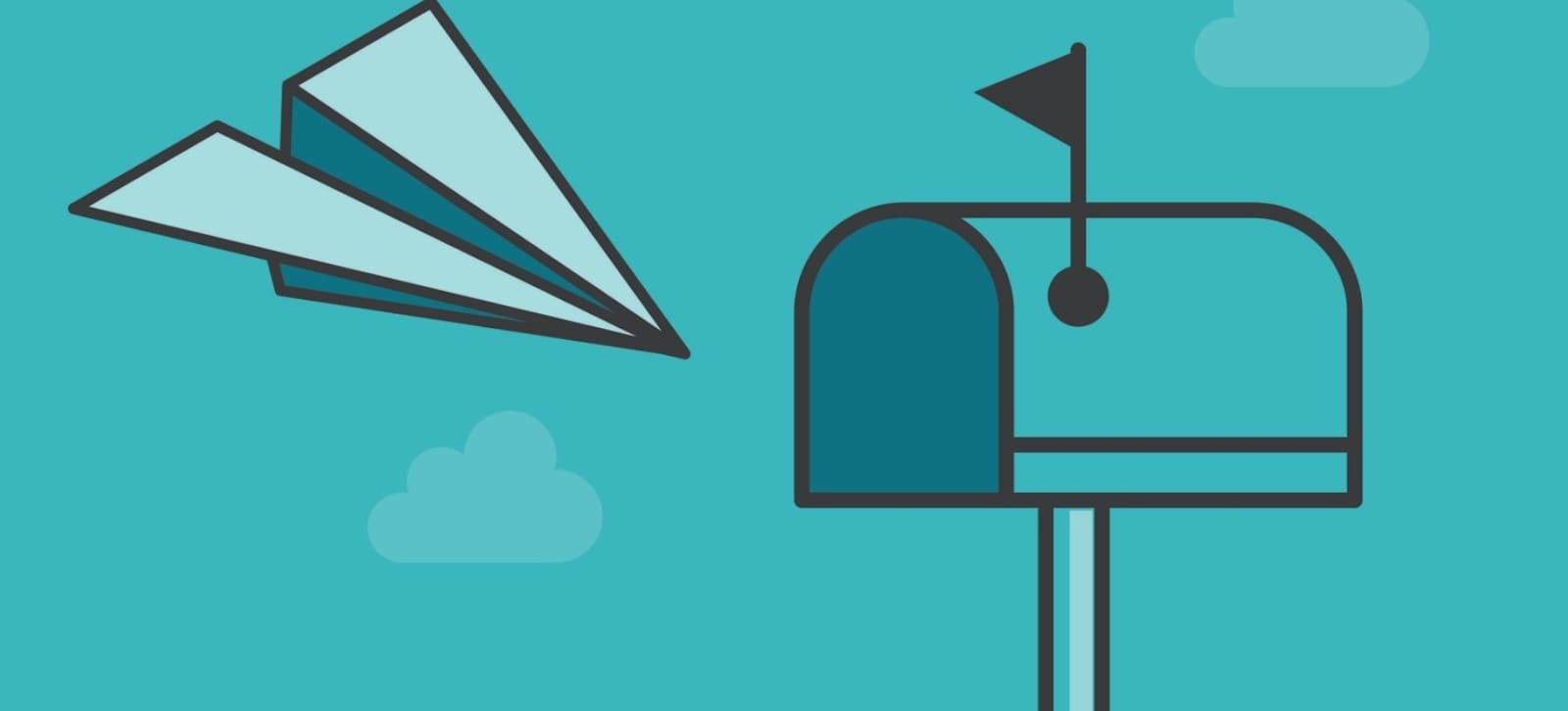
Transactional emails are automated one-to-one emails triggered by events, interactions, or preferences within an email service or application. The primary purpose of transactional emails is to provide anticipated updates to the customers’ actions or requests. These are emails that customers expect to receive and would look in their inboxes for them.
A typical example of a transactional email is the receipt email. After a customer finishes purchasing an item on an eCommerce store, he/she receives an email that has information about the item, paid price, and shipment. Because of this personalized purpose, transactional emails are for individuals one at a time, rather than a list of many recipients.
Some other types of transactional emails are password reset emails, comment notifications, or security checks. But I will show you more of these later.
Why are transactional emails important to an eCommerce store?

Why are transactional emails important to an eCommerce store?
Since customers expect transactional emails, eCommerce companies don’t need to obtain permission from them to send emails. Businesses can simply set up transactional emails to communicate important information with the audience at critical moments during the customer journey.
Transactional emails are important to an eCommerce store for many reasons, such as:
- Actively requested by customers: Think about a password reset email or an order receipt email, if a customer doesn’t receive them, there’s a good chance that the customer would reach out to make sure their request is accepted. This makes transactional emails a basic function of an eCommerce website, and if you lack them, the shopping experience can be considered worse.
- Save time with automation: Behavior-based automated emails like this are much smarter and allow you to personalize the messages. For example, you can trigger an abandoned shopping cart email when a visitor leaves without buying, all through the automation features of your email service.
- Extend existing customer relationships: You can send personalized emails based on customers’ actions and inactions, which means a better shopping experience and more satisfaction, leading to a better relationship and more loyal customers.
- Effective marketing tool: Because people expect transactional emails, they are more likely to open the emails and not flag them as spam emails. It can also be the difference between which tab Gmail puts your emails in. This makes transactional emails a valuable opportunity for additional marketing efforts.
- Require little to no cost to set up: With most free email marketing tools, you can set up triggered emails like transactional emails and don’t spend any more budget. The low number of emails and the efficiency are enough reasons for any eCommerce business to try it out.
Types of transactional emails (with examples)
Most transactional emails are very easy to identify, since they contain important information related to the customers. Here are the types of transactional emails with real-life examples that your eCommerce store can use:
Order confirmation email
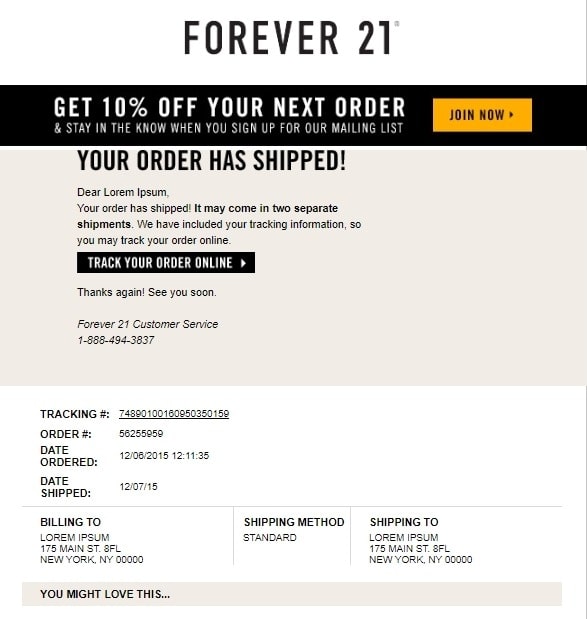
This is the most well-known type of transactional email, which triggers after a successful transaction. The customer receives an email containing information about the purchase with order information, confirmation, and receipt. It is likely that you have received this type of email already if you bought from any eCommerce store. The order confirmation email is also an opportunity to cross-sell and upsell related items, like in the example above.
Shipping confirmation email
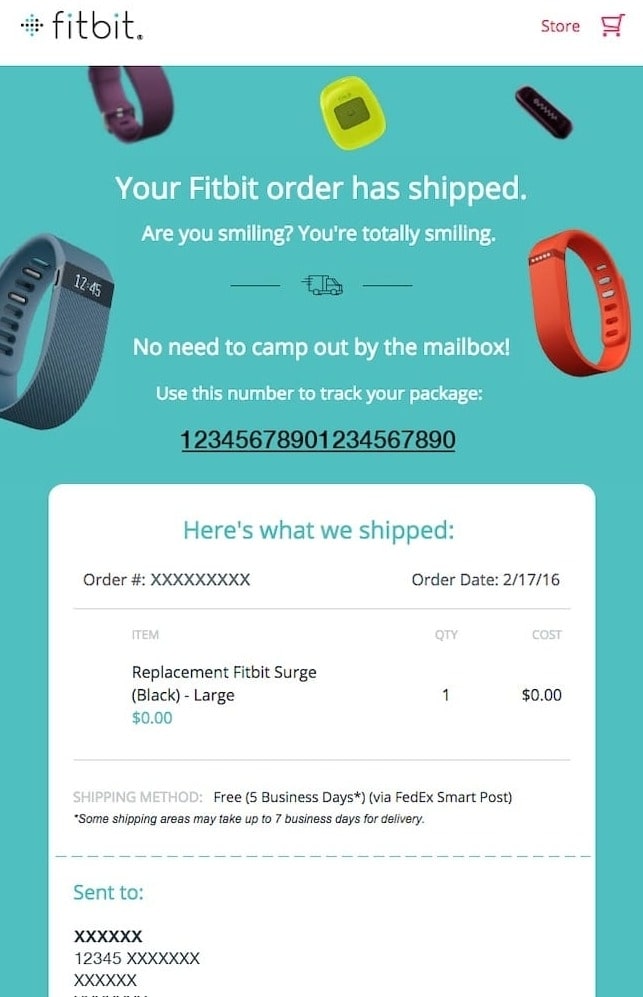
Another type of automation transactional email is shipping confirmation email - which is sent to customers when the shipping process begins. In the emails, you can include the shipping information, arrive date, and a shipping code to track through the shipping service app.
Security check email

Cyber security is important, so a transactional email for every time a user logs in or accesses from a new device, an email is both a function and a protective measure. The security check email will help customers feel that their data is safe and know when to take further actions.
Password reset email

We’ve all forgotten our passwords before, and the easiest way to log in is to click on the “forgot my password” button and receive an email with a password reset link. This email contains important information that is personal and automated for each user, making transactional emails the best option.
Customer feedback email
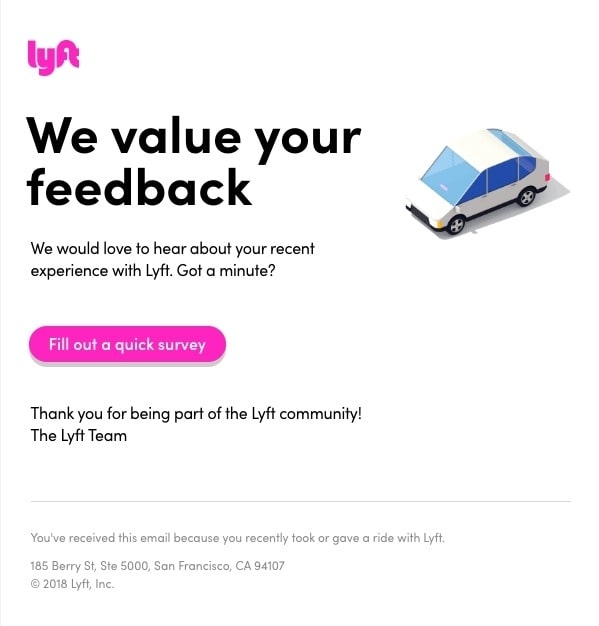
Feedback is essential to any business, but it is not so easy to obtain. Customers rarely actively look for a feedback form, so customer feedback email is the perfect transactional email to help them send their thoughts on your company more easily. With a little bit of reward, the customers are even more likely to send feedback.
Welcome email
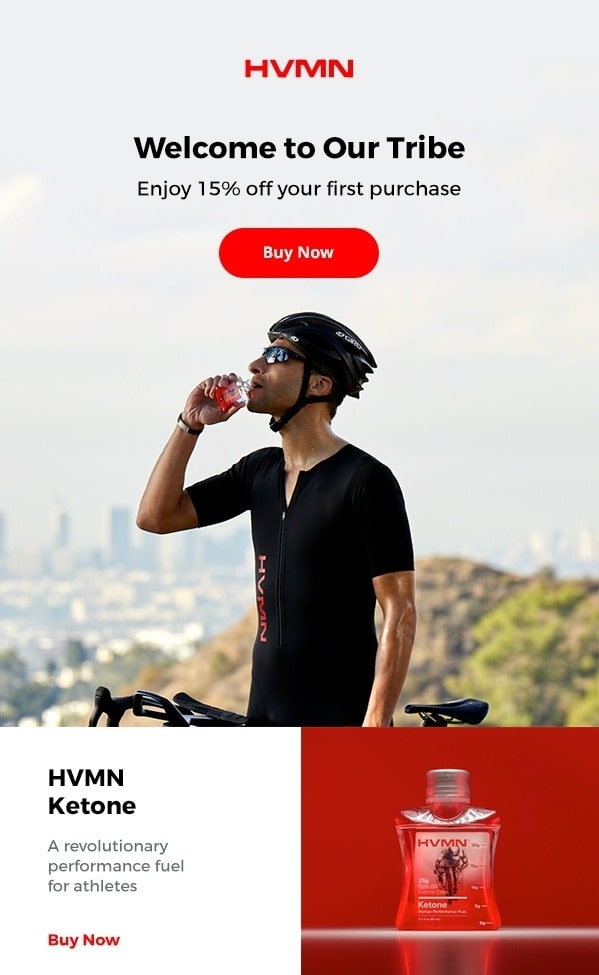
Welcome emails are sent after users sign up for an account, subscribe for newsletters, or provide contact information on your landing pages. Welcome emails help customers know that they entered the correct information and know the next steps to take with your products and services. This is also a chance for you to introduce yourself as a brand.
Double opt-in email
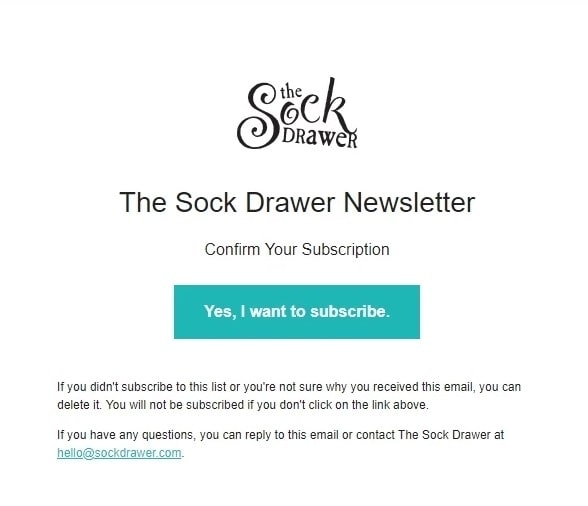
Double opt-in emails are what visitors receive after they have filled out a form and these emails let them confirm their information. These also allow you to add the customers’ email addresses and important information to your list, while checking if the contact information is legitimate and valid.
Notification email

Some eCommerce stores can send transactional emails when there is activity or interaction from other users with a user’s profile. This is relevant to companies that want to incorporate social network and community elements into their website. Think of these notification emails as emails from Facebook, notifying when someone posts on your wall or reaches out through with messages.
Create Auto Transaction Emails in Minutes
Learn more7 most popular transactional email templates
With the 7 types of transactional emails above, here are the email templates that you can apply for your company right now. These templates are easy to edit, professional, and you can access or make them with our app - AVADA Email Marketing. The best thing about using our app is the automation, which means these emails will be sent automatically when an event triggers, saving you a lot of time and effort.
Order confirmation email template
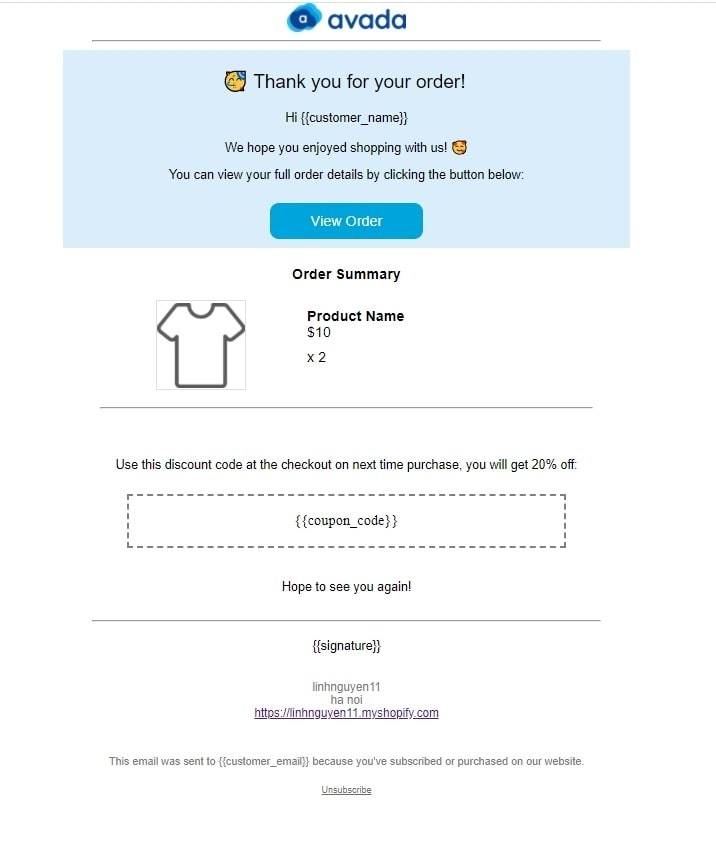
For order confirmation email, I have two templates for you, with and without a coupon. If you want to encourage the shoppers to continue making a second purchase in the future, a coupon is perfect for the task. And if you only want to confirm the order with the customers, then you don’t need to use a coupon, but I still highly recommend the coupon.
Besides that, in the app, you can use a blank template to further customize the email. You can include a form for feedback, review site, and social media accounts to follow. The possibilities are up to your imagination with the order confirmation emails. In this, I will show you the order confirmation email template with a coupon.
In the email, you start with thanking the customer for their order, then let them view the order information like the bought product, quantity, and price. There is also a button so the customer can view the order on the website and make any necessary changes. Below, a coupon code of 20% is available for the next purchase. Your buyers can add the coupon at the next checkout.
Shipping confirmation email template
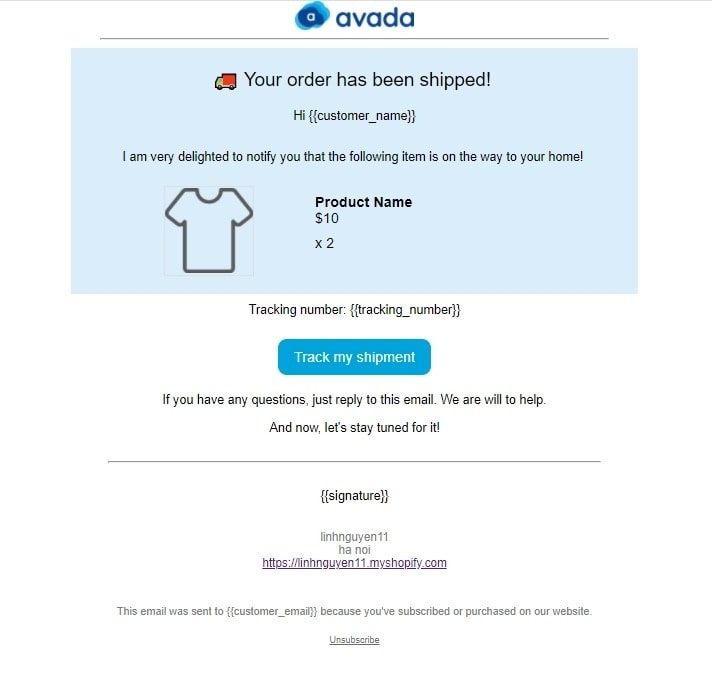
In the shipping confirmation email, you need to notify your buyers that the order has been shipped, so that is exactly what the first headline says out loud. Below, the customer can see the product information with the price and quantity, remember to personalize the email with the customer’s name. Then, the customer can track their shipment with the tracking number and a button. Then, the email reminds that shoppers can contact through this email if they need any assistance, which is really helpful.
Return/refund confirmation email template
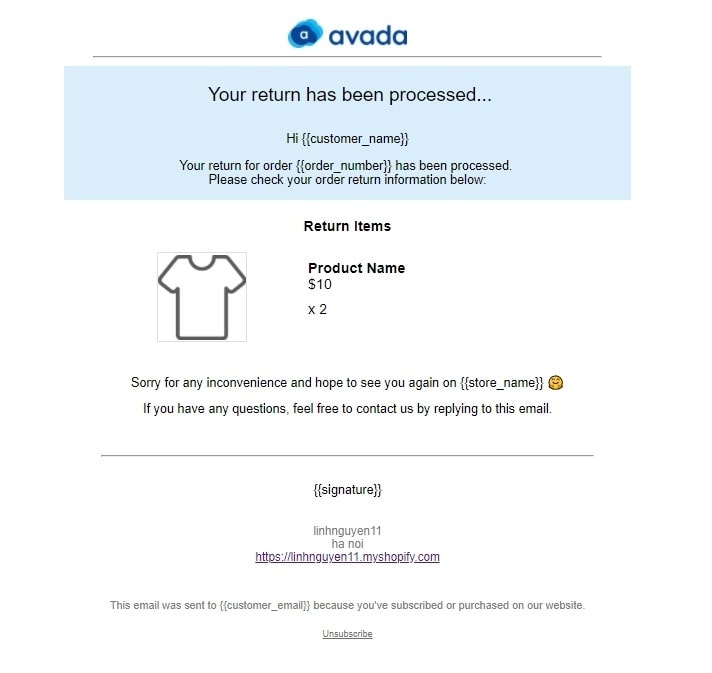
For eCommerce, return/refund is not a desirable action from customers, but it is hard to avoid. After all, you can satisfy every buyer. If you want to automate the return/refund process (like a 15 day refund policy with no question), then a return/refund confirmation email is necessary.
In the email, you let the customer know that the return/request has been processed, and ask them to check the return items. Then, the template says a professional apology and lets the customer provide further feedback right through the email. If you want to add another email for feedback, you can set up an automated sequence in the app.
Password reset email template
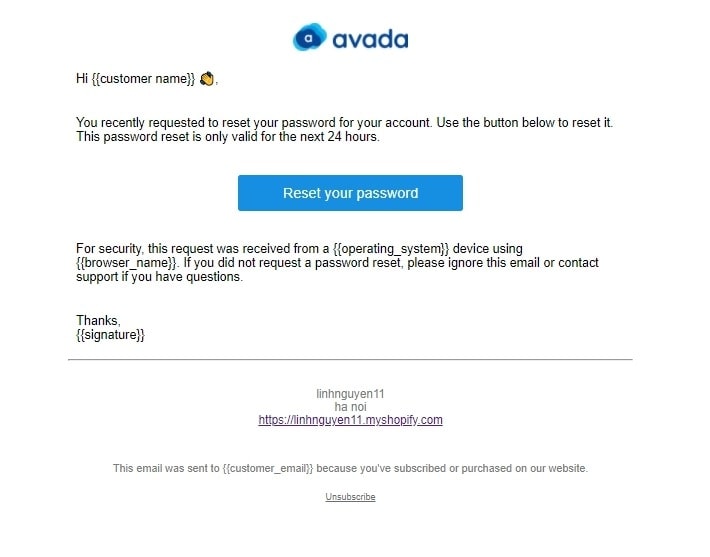
The password reset email template lets your users take the next step after they have clicked on the “Forget my password” button on your website. First, you confirm their request and give a 24 hour window to reset the password. The user just needs to click on the CTA of “Reset your password” to start resetting their password.
Below, the email lets users know the reset password request was sent from which operating system and the browser’s name. If users can’t identify the device or the browser’s name, they know that someone else is trying to reset their accounts’ passwords. This is for a security reason.
Customer feedback email template
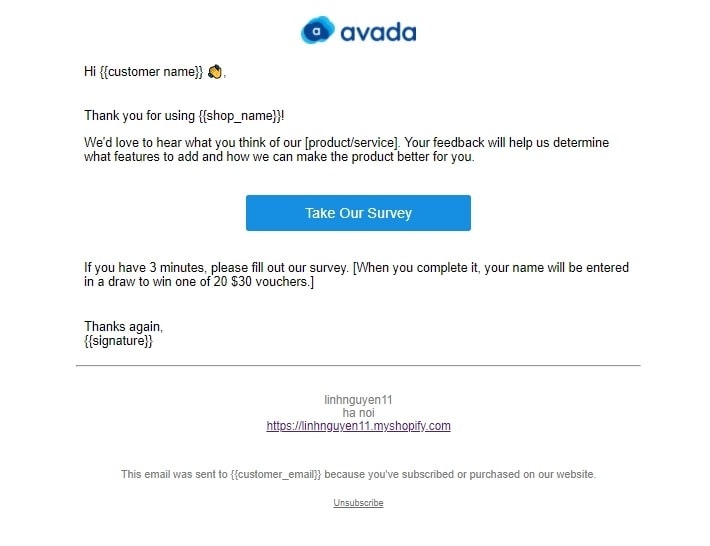
No matter the type of eCommerce, online businesses need customer feedback to further improve the selling process. In this customer feedback template, you thank the customer for using your product or service, then ask them to take a survey which can review their experience with your business.
Not everyone has time to do a survey, so you encourage the customers a bit with a chance to win a $30 voucher below, and let them know that it takes only 3 minutes to complete the survey. Saving time and earning a reward? That sounds like a good deal.
Welcome email template
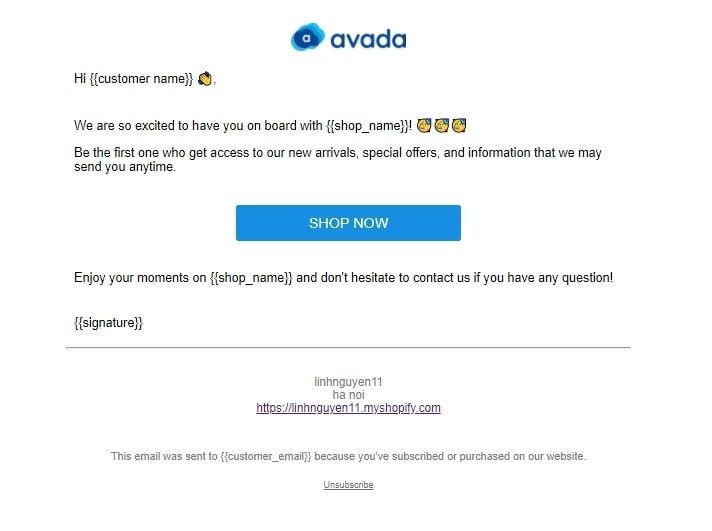
To welcome a new customer, let’s send them a warm greeting with this template. Personalize their experience by saying hello to their names and showing how excited you are to have them signing up an account. Then, a SHOP NOW button is highlighted so recipients can check out the store right the way. Lastly, you let the buyers know that they can contact if they have any questions at any time.
Our app AVADA Email Marketing has two other welcome email templates that you can use: A personal welcome email from the company’s founder and A welcome email series with a coupon to better convert new customers.
Double opt-in email template
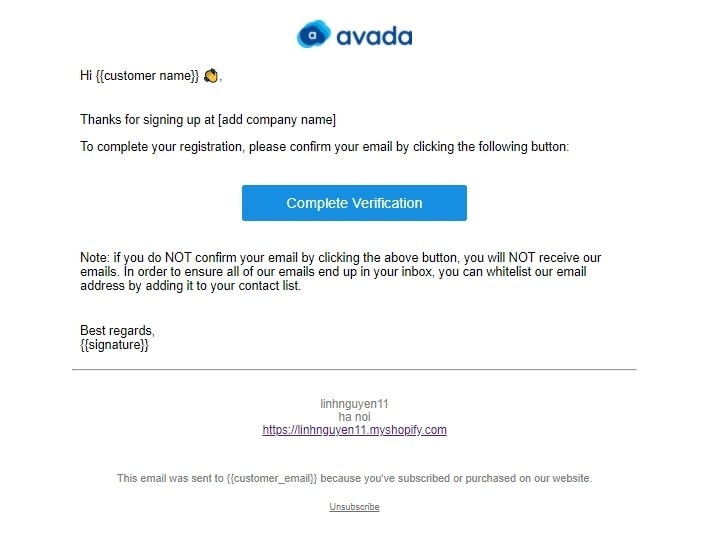
Ideally, double opt-in emails will help you filter and maintain only the readers that show interest in your content and offers. Here is a simple template that makes new readers complete the subscription or signing up process. The email starts simply with a thanks and asks the users to complete the verification by clicking on the CTA with the same message.
Below, you leave a note with users that if they do not complete verification, they won’t receive emails from your company. And if they want to ensure that they can receive all of your emails, they can whitelist your business’s email address and Gmail won’t flag any email as spam.
Related posts:
- 11 Welcome Email Templates That Always Win
- Proven Pre-purchase Email Templates
- Shopify Abandoned Cart Email Templates
- 10+ Best Confirmation Email Templates
Best practices for transactional emails

Transactional emails are another interface to your eCommerce website, so you should treat them as a vital part of your user’s experience. Here are the best practices to craft perfect transactional emails:
Write good meta information
With the way customers scan and preview sender information, meta information helps convey the most relevant information within its limited space. It may seem like a small detail, but with hundreds of emails having the same little problem, the inconvenience also multiplies.
The first thing recipients see is the sender, so make sure you use a nicely formatted address for your “From” section. For transactional emails, you should use the company’s name and the direct customer support staff’s name, like “AVADA” and “John from AVADA”. If there are more departments, you can have address names like “AVADA Support” and “AVADA Billing”.
Subject lines can get a bit trickier, but you should convey all the necessary information within fifty characters, so customers can know what the email is for right the way. For example, a shipping confirmation email can say “Your order is shipping Wednesday, December 2nd”. You can push some information into the pre-header if the subject line can’t fit all key information.
Another subtle consideration is to write subject lines that enable filtering by customers. If all your emails are from “notification@example.com,” users can filter emails based on the address. Then, your subject line keywords will help customers find emails more easily.
Avoid spam laws
Email laws worldwide regulate the sending of commercial emails, covering bulk messaging as well as other promotional emails that aim to send products. Under these laws, transactional emails don’t have to comply with them, but if they have commercial content, like a coupon or an invitation to a loyalty program, email providers can determine they are primarily commercial messages.
To avoid spam penalties, you need:
- Your subject lines should explicitly state the email’s purpose.
- More transactional content than promotional content.
- Transactional information appears at the beginning of the email.
Which is why you should leave your promotion offer at the end of transactional emails, because the rules can be more strict for these types of emails.
Send them quickly
Transactional emails need to be automated to be time-efficient and timeliness, more than any other type of email. For order confirmation and welcome emails, you should send them immediately when the triggers happen. The quicker customers receive them, the better they will feel about your business and the shopping experience.
With support requests, you should get to customers within an hour. According to a study by SuperOffice, 62% of companies ignore customer service emails, so just an automated email saying that you have processed the request can help you stay ahead of the competition.
Master the design and content
Designing an email is a tricky business, but emails remain the key touchpoint for anyone that contacts with your business. While every business is different, all your transactional emails should look beautiful on mobile devices. Fortunately, most email services nowadays can support your emails to look great on mobiles.
For the content, personalization is the answer. You have a lot of information to customize the message just for each customer. A receipt email with the customer’s name can be what makes the difference. You can also tweak the time stamps to ensure that the emails are displayed in the customers’ time zone.
Also, it is useful for recipients to manage their notification reference with transactional emails or unsubscribe from some notifications. This is not required, but the user experience can elevate with this simple feature. Ideally, customers should have the option to unsubscribe from specific notifications, but you may need some additional engineering.
Final advice
Transactional emails can be quite complex, and some may consider them a tedious task rather than a vital type of email. But they are an essential part of the eCommerce store, so taking care of transactional emails can give your customers the best possible experience. You can stand out from the crowd, improve deliverability, and build brand loyalty as more customers interact with your well-made transactional emails.
The best transactional emails are automated transactional emails, so don’t hesitate to install our app - AVADA Email Marketing, and apply them now. If you need any help setting up or using the app, feel free to contact me!
New Posts






